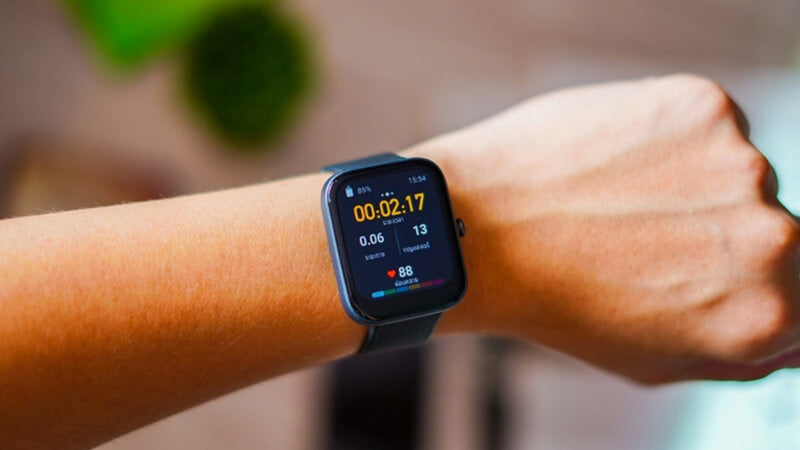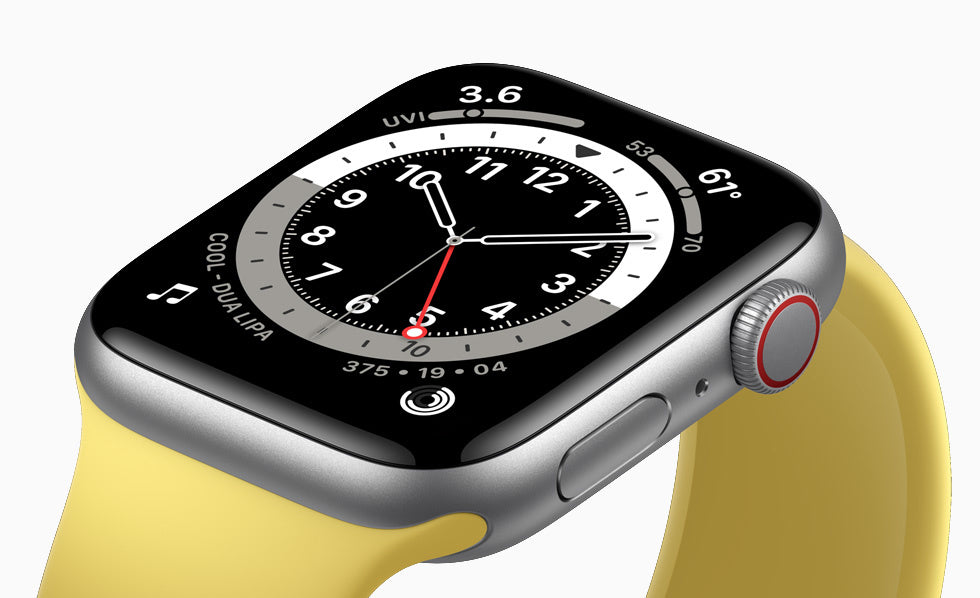Activity Tracker vs Smartwatch: What’s the Difference?
The differences between an activity tracker and a smartwatch can sometimes be hard to spot. They are two distinct types of smartwatches. Which one do you need and when? Which fits your lifestyle best? And is there a combination of both? In this blog, we dive deeper into these questions to help you understand the difference between an activity tracker and a smartwatch.
An Activity Tracker
Activity trackers monitor your daily activities, a name that literally means ‘activity tracking’. That’s essentially what an activity tracker does. To track all these activities, it uses multiple built-in sensors. Depending on the model and capabilities of your activity tracker, it can monitor:
- How many steps you take in a day
- How your heart rate changes during intense workouts
- Your route when running, cycling, or walking
- Your sleep patterns
- Your breathing during sleep
- Your blood oxygen levels
- How many calories you burn during exercise
Pairing an Activity Tracker with Your Smartphone
To view detailed statistics and analyses of your daily activities, an activity tracker always requires a companion app you can download on your smartphone. For example, the Amazfit Bip 3 Pro uses the Zepp App, while Samsung utilises the Samsung Health app.
![]()
With these apps, you can see, for instance, when your heart rate was high or low. If you notice your heart rate isn’t high enough during a workout, you can set a goal to keep it between 150 and 180 BPM (beats per minute) for your next session. You might extend your warm-up or make it more intense. This simple approach adds value to your workout and health.
Examples of Activity Trackers
Fitbit Charge 5
![]()
The Fitbit Charge 5 is an advanced activity tracker that monitors your daily life 24/7. With its daily readiness score, you can see exactly what your body needs. It provides daily recommendations for workouts or recovery exercises based on your body’s requirements. As you get fitter, the exercises become more challenging.
The Fitbit Charge 5 also features built-in GPS to guide you during running, cycling, or walking. You can see exactly where you’ve been, how fast you moved, and the distance covered, all without needing your phone.
With Fitbit Pay, you can make contactless payments. Through the Fitbit app, you can add payment cards to your Wallet. Once added, the built-in NFC chip lets you pay contactlessly, even without your phone or wallet.
The Fitbit Charge 5 has a slim rectangular display that fits comfortably around your wrist. The band is removable and interchangeable depending on the occasion or style you prefer. Check out our Fitbit Charge 5 straps to always have the perfect band for your wrist.
The Fitbit Charge 5 is available from £129.00.
Read the detailed Fitbit Charge 5 review for more specifications on this advanced activity tracker.
Affordable Alternatives
The Amazfit Bip 3 Pro is an activity tracker with handy smartwatch features. With a battery life of about 2 weeks, depending on usage, it’s ideal for trips to the mountains. You can also set it to receive smartphone notifications on the Bip 3 Pro. It’s available from £59.95.
The Huawei Band 7 is designed for avid sports enthusiasts. With over 96 refreshing sport modes and 4000 watch faces, it’s a steal at £57.99. You can replace the band and adjust the style for any situation. Check out the Huawei Band 7 straps to try different styles.
The Fitbit Inspire 2 offers personal guidance for health and fitness. When you reach your target heart rate zones, the activity tracker vibrates to let you know you’re engaging in heart-pumping activities. It also boasts a battery life of about 10 days. It’s available from £69.00.
A Smartwatch
A smartwatch is an extension of your smartphone, keeping you connected to the world just like your phone. You receive notifications on your smartwatch for incoming calls, text messages, emails, social media, and your calendar. Some smartwatches allow you to answer calls and message with the smartwatch. It’s also possible to pay with your smartwatch contactlessly.
Using Multiple Apps
A smartwatch can run multiple apps because it’s an extension of your phone. Many of these apps are activity tracking apps or tools to keep your phone in your pocket and use your smartwatch more.
Todoist
Todoist for Apple Watches is a handy app for creating a to-do list. It makes it easy to track and check off tasks. You can dictate tasks or enter them manually, giving you a quick overview of what you’ve done and what’s left.
Wrist Flashlight
With the Wrist Flashlight, you can use the flash function on your Galaxy Watch. You can dim or brighten the intensity and change the light colour to red, blue, or orange besides white.
Example of a Smartwatch
Apple Watch SE 2021
![]()
The Apple Watch SE 2021 is a versatile smartwatch. With this smartwatch, you’re always and everywhere reachable, staying updated on incoming calls, text messages, and emails. Respond to texts with custom preset messages and answer calls with a single tap.
You can also download most apps available on your iPhone onto the SE 2021. Discover various apps for daily convenience, such as Todoist, sports apps, and even games like Snake. Additionally, this smartwatch can track activities, monitoring your heart rate in BPM and providing sleep analysis like an activity tracker, making it highly versatile.
The Apple Watch SE 2021 is available from £279.00.
Affordable Alternatives
The Garmin Vivoactive 4s combines a smartwatch and sports watch. With Garmin Pay, you can make contactless payments (note, not all banks are supported). Enjoy the built-in music player and long battery life of about 7 days. The Garmin Vivoactive 4s is available from £219.99.
With the Fitbit Versa 3, you can receive and respond to call, message, and app notifications with smart replies (on Android). It also offers a 6-day battery life and fast charging. During workouts, it shows if your heart rate is in the right zone—fat burn, cardio, or peak—helping you gauge the effort needed to meet your goals. The Fitbit Versa 3 is available from £169.00.
The Samsung Galaxy Watch 4 40mm is a great fitness tracker but offers extensive possibilities thanks to Wear OS. Wear OS includes many apps that enhance the Galaxy Watch 4’s usability. The AMOLED display makes reading your screen more comfortable. The Samsung Galaxy Watch 4 40mm is available from £143.95. It’s also available in a larger 44mm size, with the Samsung Galaxy Watch 4 44mm starting at £159.00.
Activity Tracker or Smartwatch?
| Goal | Activity Tracker | Smartwatch |
| Measuring Daily Efforts | Highly suitable | Suitable |
| Creating a More Active Lifestyle | Highly suitable | Suitable |
| Measuring Sports Performance | Highly suitable | Somewhat suitable |
| Comfortable Design | Highly suitable | Highly suitable |
| Downloading Various Apps | Not suitable | Highly suitable |
| Receiving Notifications (e.g., calendar and reminders) | Somewhat suitable | Highly suitable |
| Responding to Messages and Incoming Calls | Not suitable | Highly suitable |
Smartwatch and Activity Trackers Combined
For those unable to choose between an activity tracker and a smartwatch, there’s no need to worry. Technology has advanced enough to combine the two. Depending on the brand and model, it leans more towards one side of the spectrum. Typically, you’ll find a smartwatch with activity tracker features or an activity tracker with smartwatch capabilities. You should decide based on which features you value and what fits your goals and lifestyle.
Differences Between Activity Tracker and Smartwatch
| Activity Tracker | Smartwatch | |
| Purpose | Tracks performance data to promote an active lifestyle. | An extension of your smartphone, minimising the need to use your phone. |
| Design and Comfort | Activity trackers are often slim watches designed for comfort during sports and movement. | Smartwatches resemble a mini smartphone on your wrist, suitable for all occasions. |
| Notifications | Not all activity trackers support notifications, and responding to messages or calls is often limited. | Smartwatches display messages and allow responses via voice or preset messages, plus answering calls. |
| Battery | Activity trackers are used occasionally to select a mode, with battery life ranging from 7 to 14 days depending on use. | Smartwatches are used frequently, typically lasting no more than 24 hours on a charge. |
| App Capabilities | Activity trackers specialise in activity tracking, with apps offering more accurate and detailed options than smartwatches. | Smartwatches offer extensive app possibilities, including activity tracking, making them versatile. |
| Price | The focus on activity tracking makes activity trackers generally more affordable. | Smartwatches are pricier due to their versatility, apps, and additional activity tracking capabilities. |
Conclusion
Activity trackers and smartwatches share many similarities but are not the same. The biggest difference is that a smartwatch is an extension of your smartphone in the broadest sense, handling notifications for calls, reminders, activities, social media, and messages, and allowing you to respond with preset or voice messages.
In contrast, an activity tracker specialises in measuring and tracking daily activities with greater detail than the apps offered by smartwatches. With the app that comes with your tracker, you can view data and analyses of your sports and movement activities.
Often, smartwatches include activity tracking features, and activity trackers include smartwatch capabilities. Your choice should depend on your preferences and what suits your goals and lifestyle.



Leave a comment
All comments are moderated before being published.
This site is protected by hCaptcha and the hCaptcha Privacy Policy and Terms of Service apply.